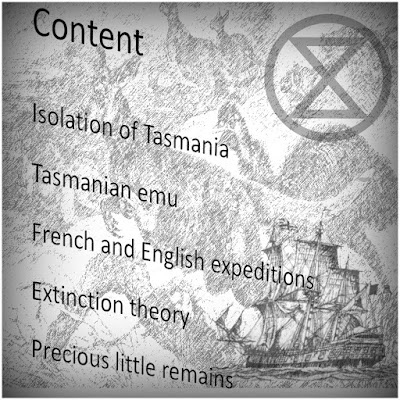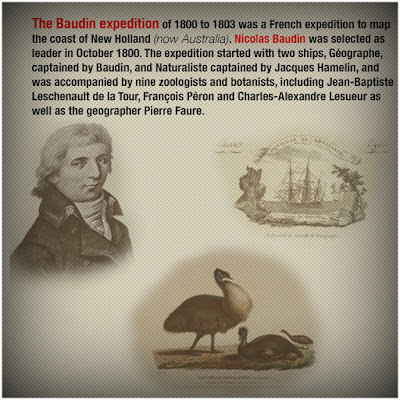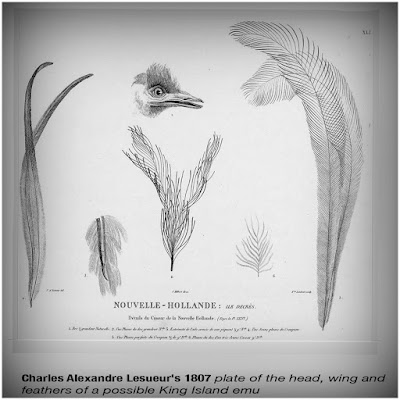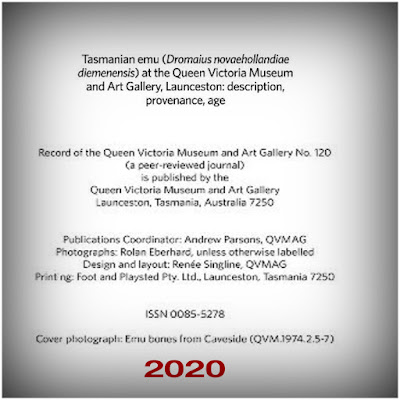Tasmania’s extinct emu is less well known than the iconic thylacine, yet just as deserving of recognition. Recent research has aged skeletal material, and DNA work has shed light on the relationships between populations. There are many theories as to why the emu became extinct so soon after European arrival in Tasmania. David Maynard will review the Tasmanian emu and current research results, and discuss the drivers for extinction.
David has been the curator of Natural Sciences at the Queen Victoria Museum and Art Gallery (QVMAG) for six years [in 2018], and in that role he works to preserve a record of Northern Tasmania’s biodiversity. Prior to taking this position he was an academic at the Australian Maritime College and University of Tasmania where he specialized in fishing gear technology, by-catch reduction and marine biodiversity. The role of curator has allowed David to do something he enjoys – continuing to learn. He has a growing understanding of terrestrial rather than marine fauna, and is focusing on Northern Tasmania’s insect and spider diversity. He also looks into Tasmania’s past, trying to understand how Tasmania has changed over the last 50,000 years.
ROYAL SOCIETY OF TASMANIA LINK
CLICK ON AN IMAGE TO ENLARGE
41mins
Aboriginal Culture and History
State Library Victoria
REVIEW AND ANALYSIS
It turns out in retrospect that this lecture came at a rather interesting time given that geographic understandings of 'place', PLACEmaking and CULTURALlandscaping was, and continues to be, in a state of flux. There is a level of scholarship that institutions like The Royal Society and the Queen Victoria Museum and Art Gallery (QVMAG) need to be engaged with. It is just the case that that 'science' is never static nor are understandings of 'cultural realities' – and nowhere more so than in Tasmania. And here we have a Tasmanian extinction that took place in about 'two generations' whereas this bird had coexisted with humans in the pre-colonial CULTURALlandscaping for 40,000 years plus goodness knows how many milllenia.
It is also of some interests, looking back, that David Maynard didn't reference Bruce Pascoe's book Dark Emu: Black Seeds: Agriculture or Accident? a non-fiction book published in 2014. It reexamines colonial accounts of Aboriginal people in Australia, and cites evidence of pre-colonial agriculture, engineering and building construction by Aboriginal and Torres Strait Islander peoples. A second edition, published under the title Dark Emu: Aboriginal Australia and the Birth of Agriculture was published in mid-2018 – just moths before the lecture. Pascoe only briefly refers to emus directly but he does talk about the CULTURALlandscapes they coexisted in with First Nation peoples.
It also turns out that in regard to extinctions in Tasmania this lecture happens at a time that might be regarded as a point in time when memories and imaginings of Tasmania's extinct emu get a something dust off. David Maynard's lecture title "Tasmania's Forgotten Emu Species" carries all the poignancy of changing and shifting cultural reimaginings and reawakenings relative to this cluster of island at the end of the earth. In a way this lecture marks something of a milestone in Tasmania's self awareness and the evolution of 'the place's' cultural sensibilities.
The heroic cultural investment on the part of 'Tasmania's First People' (TFP) in constructing a language from the vestiges of their lost languages, via which, in a contemporary context, they can articulate their identity and their survival as the oldest living culture on 'planet earth' must not be downplayed.
The language, palawa-kani, is increasingly enabling 'the people', the TFP, to articulate their survival and talk about their 'placedness' – in the place they belong to. Long before the iconic 'Tasmanian Thylacine kaparunina' went extinct circa 1930s, there was that well known assumption that with death of Truganini May 8 1876, 'the people', the TFP, went extinct – that colonial assumption has been overturned. And about a generation before that, the Tasmanian emu went extinct. So, extinction stories have been omnipresent on that cluster of islands now known as Tasmania, once known as Van Diemen's Land, and as palawa-kani tells us, before that as lutruwita.
In presenting this lecture, and remembering that it came at the tail end of the Royal Society's 2018 Lecture series, David Maynard set out to 'review' the Tasmanian emu and current research results, and discuss the drivers for extinction. In the context of his position as a 'curator', once spoken of as 'keepers', it is worthwhile taking note of the observation of Nobel Laurent Prof. Brian Schmid – astrophysicist, cosmologist, researcher and ANU Vice Chancellor. Paraphrased, Prof. Schmidt alerted the world to the reality that universities, and by extension 'public museums', ceased being the entrusted 'curators of, keepers of', knowledge and information circa 1980. As a 'researcher and thinker' his observations are well worthwhile listening to.
It is important to note that at the time David Maynard delivered his lecture, like 'musingplaces' in Tasmania and elsewhere the QVMAG has been front an centre in the KNOWLEDGEkeeper paradigm. So, his lecture serves as timely 'flush out' of the institution's 'hunting and gathering'. The work that is yet to be done is the serious in depth interrogation of 'musingplaces' collections' and nowhere more so than on 'the ground' the QVMAG sits at Inveresk.
Given the institution's 'current and quite apparent imagining' of itself as some kind of quasi 'theme park' dedicated to the weird and wonderful cum tourism destination, that is unlikely to happen anytime soon.
That said, David Maynard's flush out came none too soon and that it alerts people – Tasmanians, cultural thinkers, natural scientists, historians, geographers et al – to the work yet to be done, the data that's there to be mused upon, and it'll be one of those milestones passed to gives perspective. Surely, there is a PhD thesis here just waiting to be picked up.
That Maynard was addressing the 'Royal Society'' on what clearly was once 'the island's' most fecund places onn lutruwita has a certain poignancy. In particular the histories that have caused 'this place' to be converted from a 'paradise' of a kind to an industrial wasteland and now one that seriously under threat as a consequence of 'climate change'. All this resonates rather loudly when thinking about 'The Tasmanian Emu'.
It is also worth a mention that Launceston, as a place, exists in 19th/20th Century self imagining that somewhat curiously seems to celebrate 'intinctionism'. Now that's an exhibition, publication, podcast, whatever that the city via it 'captive musingplace' is yet to launch – it'd be a winner for the QVMAG.
Curiously, the city celebrates 'the thylacine' and has adopted it as a component of the city's heraldic emblem. However it seems to have forgotten 'the emu' that arguably, and as the evidence suggests, once had an important place in the fecundity of this place ponrabbel CULTURALlandscape at the confluence of kanamaluka Tamar and two river systems on lutruwita. It is beyond the scope of this review to plumb the depths of this particular cultural mire – that is something for a PhD candidate at sometime in the future. Suffice to reiterate President Ronald Regan's saying "the status quo is quite simply Latin for the messy we are in".
It is just a pity that neither the QVMAG nor the Royal Society has not published David Maynard's 2018 lecture as on online essay, a podcast or in some other format that would enable more musers to muse upon the conundrum that is the 'The Tasmanian Emu'. given that the Royal Society – a founding instrument in Launceston's heritage for the QVMAG – is an organisation dedicated to the 'advancement of knowledge' the lecture might yet set someone somewhere on a quest for not 'new knowledge' but better understandings of the lutruwita CULTURALlandscape.
In musing upon all this it needs to be acknowledged that Tasmania's public 'museums', the 'offical vectors of Tasmanianness' – Tasmanian 'placedness' – up until the present, and especially so in regard to 'the natural sciences'. They have been imagined as cathedrals of the enlightenment – Eurocentric to the core.
Essentially, they have modelled themselves on their British archetypes of Empire – the British Museum & The Victoria and Albert Museum – full as they are to the gunnels with the 'plunder of empire' – in Tasmania same imperative just slightly different plunder. This is shifting but ever so slowly and ever, ever so reluctantly.
What might well work looking ahead, is 'musingplaces' that operates outside the so-called KNOWLEDGEsilos of the 'status quo' in a paradigm of 'public musing places' where all so, so much is currently invested in essentially maintaining the comfort of the current state of affairs. Rather, it will require a circumstance of egoless collaboration and cooperation. While ever a musingplace entertains the notion that 'it' is the 'curator and keeper' of knowledge, belief systems and cultural sensibilities it will moulder away and turn to dust just as surely as GOD made little apples – Y.
In brief, David Maynard delivered something of an exposé of the QVMAG's 'hunting and gathering'. The research and scholarship is there to be be done. Some searching has been done over time, forgotten largely, now is the time for the start of the research. Searching and research are not the same thing albeit that 'research' does depend quite a bit upon the hunting and gathering phase – AKA the literature search.
ACKNOWLEGEMENTS
The QVMAG's generosity in providing access to David Maynard's POWERpoint imagery is acknowledged. Without it memories of the lecture would surely have been flawed. Likewise, the QVMAG's publication relative to 'Tasmania's Forgotten Emu' has been an invaluable reference as it surely will be for anyone taking up the challenge to interrogate the lutruwita islands' CULTURALlandscaping. Likewise, the numerous 'corespondents' who have been involved in testing the cultural realities that inform Tasmanian 'placedness', and in an ongoing way, is much appreciated.
This reference has been created as a component of a research process built upon the foundation of 'open access critical review' supported as it is by 21st C communication paradigms. The 'Moral Rights' of the authors are acknowledged. The process is a deSILOING process that hopefully researchers will more often employ. Additionally, the methodology affords rhizomatic interfacing towards expanding the research networks.in play.
QVMAG PUBLICATION
Tasmanian Emu (Dromaius novaehollanddiae diemenensis)
at the Queen Victoria Museum and Art Gallery

Independent researcher, cultural geographer, cultural producer & miner of deep histories.

























No comments:
Post a Comment